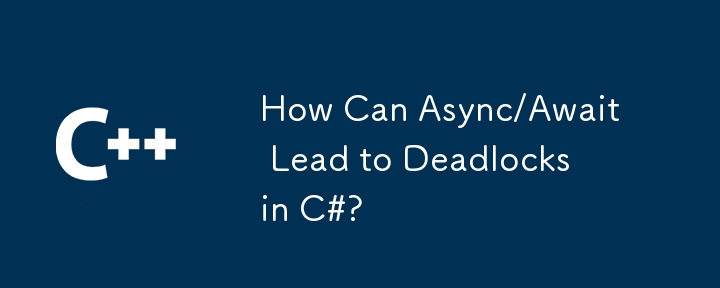Home >Backend Development >C++ >How Can Async/Await Lead to Deadlocks in C#?
How Can Async/Await Lead to Deadlocks in C#?
- Patricia ArquetteOriginal
- 2025-02-02 01:41:13712browse

Understanding Async/Await Deadlocks in C#
Modern programming relies heavily on asynchronous operations, and C#'s async/await keywords offer a streamlined approach. However, improper usage can lead to deadlocks. Let's examine a common scenario:
Consider this example:
<code class="language-csharp">public ActionResult ActionAsync()
{
// DEADLOCK: Blocking on the async task
var data = GetDataAsync().Result;
return View(data);
}
private async Task<string> GetDataAsync()
{
// Simple asynchronous method
var result = await MyWebService.GetDataAsync();
return result.ToString();
}</code>
This code attempts to retrieve data asynchronously but synchronously waits for the result using .Result, creating a deadlock. The deadlock arises as follows:
-
ActionAsynccallsGetDataAsync. -
GetDataAsyncinitiates an asynchronous web request viaMyWebService.GetDataAsync. -
MyWebService.GetDataAsyncreturns an incomplete task. -
GetDataAsyncsuspends, returning an incomplete task toActionAsync. -
ActionAsyncblocks on the incomplete task fromGetDataAsync, halting the context thread. - The web request eventually completes, resuming
GetDataAsync. -
GetDataAsync's continuation needs the context thread, which is blocked byActionAsync. - A deadlock occurs:
ActionAsyncwaits forGetDataAsync, which waits for the blocked context thread.
This illustrates the critical importance of avoiding synchronous waits on asynchronous operations within asynchronous methods. Always allow the asynchronous operation to complete naturally, using await where appropriate.
The above is the detailed content of How Can Async/Await Lead to Deadlocks in C#?. For more information, please follow other related articles on the PHP Chinese website!
Related articles
See more- C++ compilation error: A header file is referenced multiple times, how to solve it?
- C++ compilation error: wrong function parameters, how to fix it?
- C++ error: The constructor must be declared in the public area, how to deal with it?
- Process management and thread synchronization in C++
- How to deal with data splitting problems in C++ development

